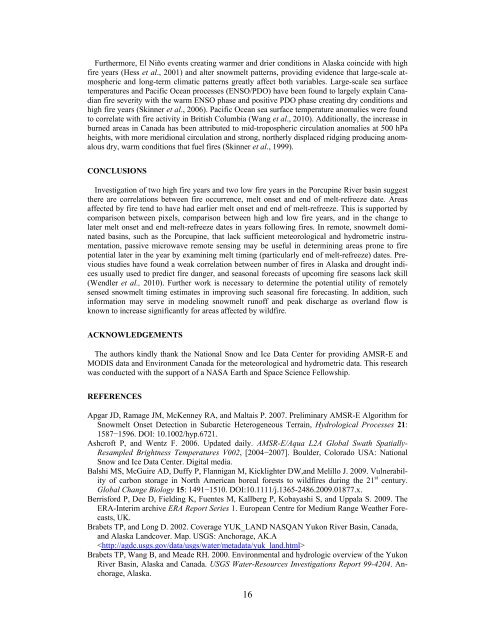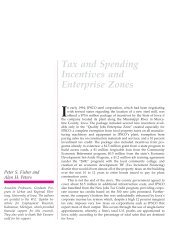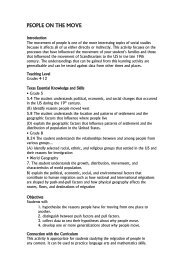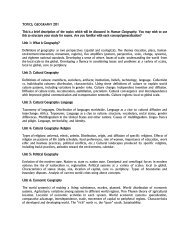Investigating Correlations between Snowmelt and Forest Fires in a ...
Investigating Correlations between Snowmelt and Forest Fires in a ...
Investigating Correlations between Snowmelt and Forest Fires in a ...
You also want an ePaper? Increase the reach of your titles
YUMPU automatically turns print PDFs into web optimized ePapers that Google loves.
Furthermore, El Niño events creat<strong>in</strong>g warmer <strong>and</strong> drier conditions <strong>in</strong> Alaska co<strong>in</strong>cide with high<br />
fire years (Hess et al., 2001) <strong>and</strong> alter snowmelt patterns, provid<strong>in</strong>g evidence that large-scale atmospheric<br />
<strong>and</strong> long-term climatic patterns greatly affect both variables. Large-scale sea surface<br />
temperatures <strong>and</strong> Pacific Ocean processes (ENSO/PDO) have been found to largely expla<strong>in</strong> Canadian<br />
fire severity with the warm ENSO phase <strong>and</strong> positive PDO phase creat<strong>in</strong>g dry conditions <strong>and</strong><br />
high fire years (Sk<strong>in</strong>ner et al., 2006). Pacific Ocean sea surface temperature anomalies were found<br />
to correlate with fire activity <strong>in</strong> British Columbia (Wang et al., 2010). Additionally, the <strong>in</strong>crease <strong>in</strong><br />
burned areas <strong>in</strong> Canada has been attributed to mid-tropospheric circulation anomalies at 500 hPa<br />
heights, with more meridional circulation <strong>and</strong> strong, northerly displaced ridg<strong>in</strong>g produc<strong>in</strong>g anomalous<br />
dry, warm conditions that fuel fires (Sk<strong>in</strong>ner et al., 1999).<br />
CONCLUSIONS<br />
Investigation of two high fire years <strong>and</strong> two low fire years <strong>in</strong> the Porcup<strong>in</strong>e River bas<strong>in</strong> suggest<br />
there are correlations <strong>between</strong> fire occurrence, melt onset <strong>and</strong> end of melt-refreeze date. Areas<br />
affected by fire tend to have had earlier melt onset <strong>and</strong> end of melt-refreeze. This is supported by<br />
comparison <strong>between</strong> pixels, comparison <strong>between</strong> high <strong>and</strong> low fire years, <strong>and</strong> <strong>in</strong> the change to<br />
later melt onset <strong>and</strong> end melt-refreeze dates <strong>in</strong> years follow<strong>in</strong>g fires. In remote, snowmelt dom<strong>in</strong>ated<br />
bas<strong>in</strong>s, such as the Porcup<strong>in</strong>e, that lack sufficient meteorological <strong>and</strong> hydrometric <strong>in</strong>strumentation,<br />
passive microwave remote sens<strong>in</strong>g may be useful <strong>in</strong> determ<strong>in</strong><strong>in</strong>g areas prone to fire<br />
potential later <strong>in</strong> the year by exam<strong>in</strong><strong>in</strong>g melt tim<strong>in</strong>g (particularly end of melt-refreeze) dates. Previous<br />
studies have found a weak correlation <strong>between</strong> number of fires <strong>in</strong> Alaska <strong>and</strong> drought <strong>in</strong>dices<br />
usually used to predict fire danger, <strong>and</strong> seasonal forecasts of upcom<strong>in</strong>g fire seasons lack skill<br />
(Wendler et al., 2010). Further work is necessary to determ<strong>in</strong>e the potential utility of remotely<br />
sensed snowmelt tim<strong>in</strong>g estimates <strong>in</strong> improv<strong>in</strong>g such seasonal fire forecast<strong>in</strong>g. In addition, such<br />
<strong>in</strong>formation may serve <strong>in</strong> model<strong>in</strong>g snowmelt runoff <strong>and</strong> peak discharge as overl<strong>and</strong> flow is<br />
known to <strong>in</strong>crease significantly for areas affected by wildfire.<br />
ACKNOWLEDGEMENTS<br />
The authors k<strong>in</strong>dly thank the National Snow <strong>and</strong> Ice Data Center for provid<strong>in</strong>g AMSR-E <strong>and</strong><br />
MODIS data <strong>and</strong> Environment Canada for the meteorological <strong>and</strong> hydrometric data. This research<br />
was conducted with the support of a NASA Earth <strong>and</strong> Space Science Fellowship.<br />
REFERENCES<br />
Apgar JD, Ramage JM, McKenney RA, <strong>and</strong> Maltais P. 2007. Prelim<strong>in</strong>ary AMSR-E Algorithm for<br />
<strong>Snowmelt</strong> Onset Detection <strong>in</strong> Subarctic Heterogeneous Terra<strong>in</strong>, Hydrological Processes 21:<br />
1587−1596. DOI: 10.1002/hyp.6721.<br />
Ashcroft P, <strong>and</strong> Wentz F. 2006. Updated daily. AMSR-E/Aqua L2A Global Swath Spatially-<br />
Resampled Brightness Temperatures V002, [2004−2007]. Boulder, Colorado USA: National<br />
Snow <strong>and</strong> Ice Data Center. Digital media.<br />
Balshi MS, McGuire AD, Duffy P, Flannigan M, Kicklighter DW,<strong>and</strong> Melillo J. 2009. Vulnerability<br />
of carbon storage <strong>in</strong> North American boreal forests to wildfires dur<strong>in</strong>g the 21 st century.<br />
Global Change Biology 15: 1491−1510. DOI:10.1111/j.1365-2486.2009.01877.x.<br />
Berrisford P, Dee D, Field<strong>in</strong>g K, Fuentes M, Kallberg P, Kobayashi S, <strong>and</strong> Uppala S. 2009. The<br />
ERA-Interim archive ERA Report Series 1. European Centre for Medium Range Weather Forecasts,<br />
UK.<br />
Brabets TP, <strong>and</strong> Long D. 2002. Coverage YUK_LAND NASQAN Yukon River Bas<strong>in</strong>, Canada,<br />
<strong>and</strong> Alaska L<strong>and</strong>cover. Map. USGS: Anchorage, AK.A<br />
<br />
Brabets TP, Wang B, <strong>and</strong> Meade RH. 2000. Environmental <strong>and</strong> hydrologic overview of the Yukon<br />
River Bas<strong>in</strong>, Alaska <strong>and</strong> Canada. USGS Water-Resources Investigations Report 99-4204. Anchorage,<br />
Alaska.<br />
16
















